Adventurous Kate contains affiliate links. If you make a purchase through these links, I will earn a commission at no extra cost to you. Thanks!
Naples is one of my favorite places in Italy — and the world. This wild and fascinating city is chaotic, affordable and friendly. I can’t get enough of it, and I’m always thinking about my next visit.
There are so many cool things to do in Naples Italy, no matter what kind of traveler you are. (Honestly, if you did nothing but eat pizza the entire time, I would get it! It’s that good!) Of course you have cathedrals and museums and piazzas — but you also have fantastic pastries, interesting museums, and a a looming volcano in the background!
Planning your trip to Naples last minute?
Naples is a popular destination, so be sure to book hotels and tours as far in advance as possible!
🏔️ Top Experiences and Tours in Naples:
- Go on a walking food tour (a must!)
- Take a cooking class (learn to make authentic pizza!)
- Take a day trip to Mount Vesuvius (half-day tour!)
🛌 Top-Rated Hotels in Naples:
- Amadomus Luxury Suites (Close to the historic center)
- Sanfelice 33 Luxury Suites (Modern & colorful rooms)
- Il Taschino Suite (Great budget option)
🚗 Renting a car from the Naples Airport? Find deals on car rental rates here.
Beyond the city itself, Naples is perfectly positioned for some of the best day trips in Italy, from Pompeii to Capri to the Amalfi Coast.
But for me, what makes Naples special is the energy. It’s wonderfully unpretentious, full of locals who are gregarious and welcoming. And they don’t rebuild their city to cater to tourists — they know what a special place they have, and that it should be appreciated for what it is.
Naples is incredible, and I can’t wait to show you the best of the city Italians call Napoli.
This post was published in June 2023.
Table of Contents
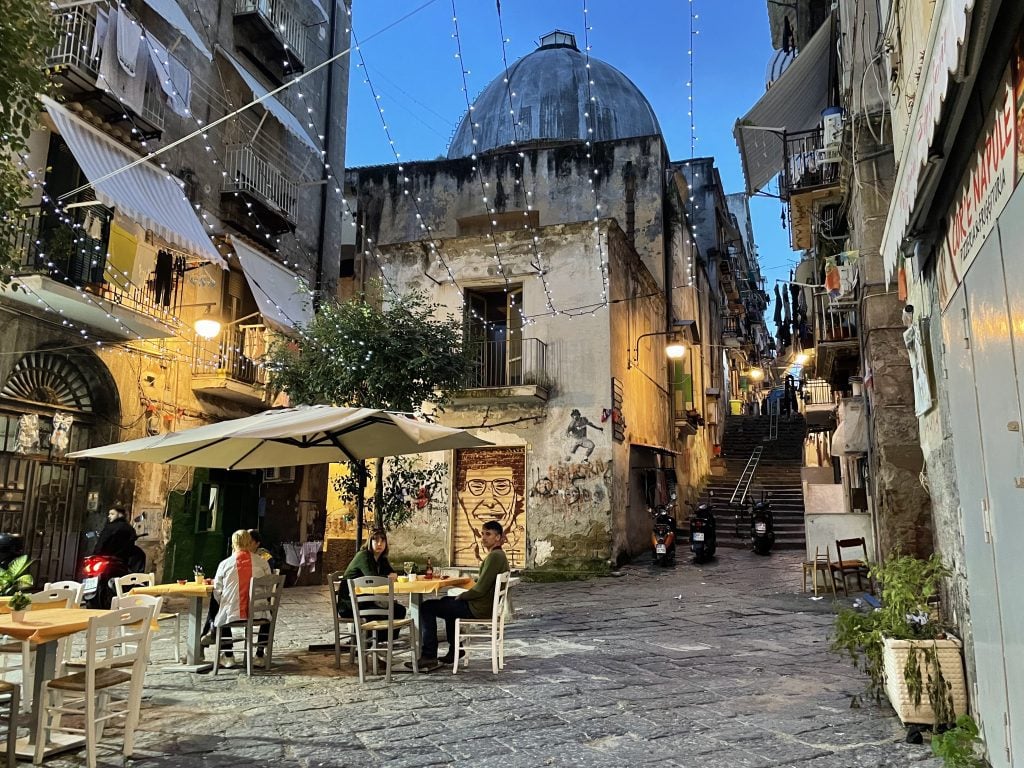
Things to Do in Naples, Italy
Definitely eat all the best pizza, visit Mount Vesuvius, explore the Old Town, and take in the Naples Archaeological Museum!
Naples is much safer than people think, and likely safer than your hometown. Treat it like any other big city and keep an eye on your belongings.
Naples is a FANTASTIC base for day trips. I recommend visiting Pompeii, Procida island, and the Amalfi Coast!
Late spring and early fall are fantastic times to visit Naples — you’ll enjoy beautiful outdoor weather and far smaller crowds. Think late May and early October.

Eat the Best Pizza in the World
If you are a pizza fiend like me, you are going to LOVE Naples. Naples is where pizza was invented! Of COURSE it’s going to be amazing!
There are so many excellent pizza places throughout Naples, and they are all cheap. Honestly, if you’re paying more than six euros for a pizza in a casual spot in Naples, you’re getting ripped off. Usually you’ll pay closer to four euros for a pizza the size of your head. (It’s more expensive at more high-end spots, though. Like eight euros for a margherita.)
So where should you go? Two of my favorite places for pizza in Italy are also two of the most famous: L’antica Pizzeria Da Michele and Sorbillo.
Da Michele is the famous pizzeria from Eat, Pray, Love, whose identity writer Elizabeth Gilbert initially kept secret before deciding to share it with the world. Get a ticket with a number outside and you’ll be ushered inside to order from their simple menu: classic margherita with fior di latte mozzarella, marinara (no cheese) or cosacca (with pecorino instead of mozzarella).
Sorbillo is a bit more formal (by Neapolitan standards, anyway) — you wait in line and sit down in the restaurant. There’s a more detailed menu with more toppings, but the pizza is just as good.
Two more modern pizzerias that I really enjoyed are Pizzeria 3.0 Ciro Cascella (one of the best margheritas I’ve EVER had, plus PIZZA DONUTS!!) and 50 Kalo (just fabulous all around). These two spots are off the beaten path and will be full of locals. Book ahead.
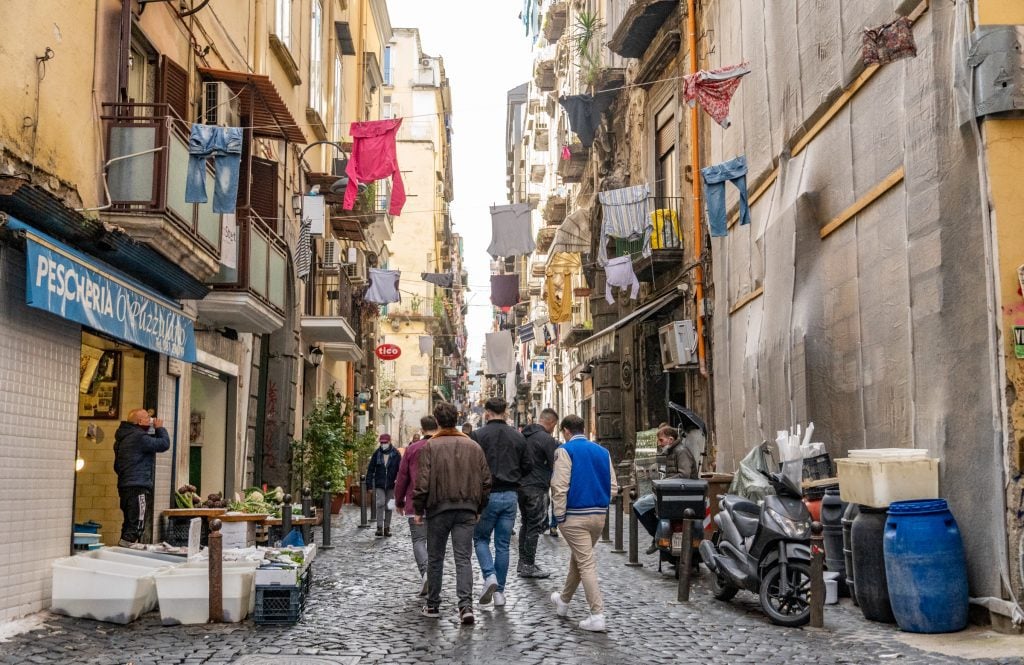
Explore the Historic Center of Naples
The historic center of Naples is a UNESCO World Heritage Site, and for good reason — it dates back to 470 BCE and carries layers upon layers of civilizations. Here you have Ancient Greek city walls, Byzantine churches, French Gothic architecture from the Angevin, and Tuscan architecture from the Aragonese.
But for me, I feel that this neighborhood is where you feel the essence of Napoli in its carefree glory. Motorcycles speed down the street, shopkeepers yell animatedly with each other, walls are covered with religious art and graffiti, and that one guy with a balcony is singing into a karaoke machine, performing for the people waiting in line for pizza at Sorbillo.
Spend time walking around this neighborhood, photographing anything that catches your interest — or just sitting back and watching the show, a big smile on your face.
And don’t miss the Quartieri Spagnoli, or Spanish Quarter — it’s just down the street from the Historic Center and is brimming with tons of character as well.
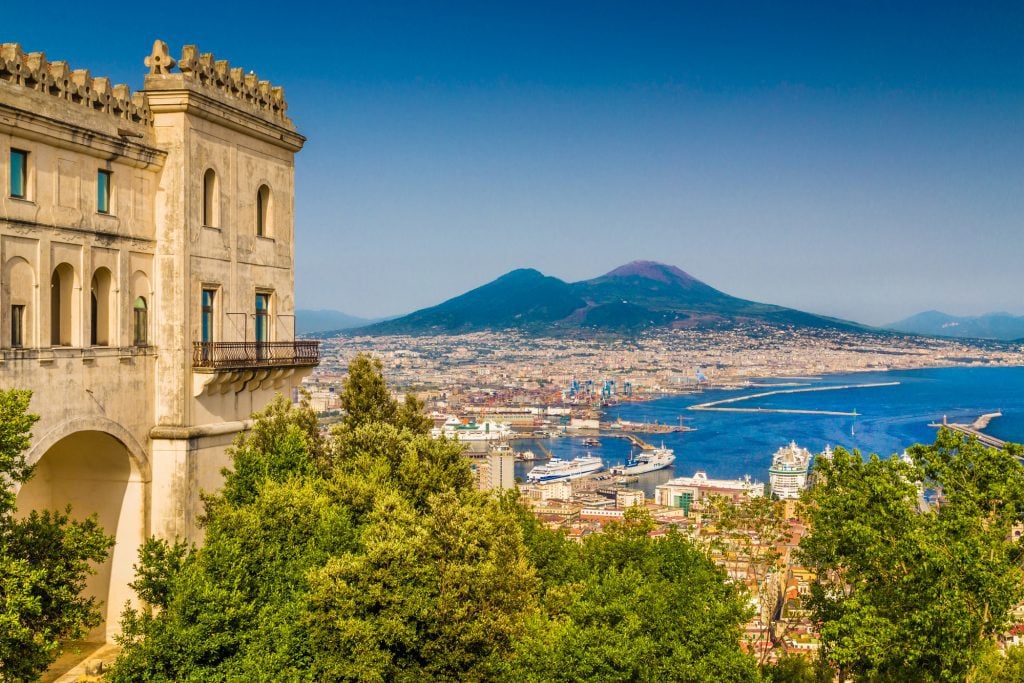
Visit Mount Vesuvius
Mount Vesuvius is one of the symbols of Naples, towering over the city and its surroundings. Vesuvio, as the Italians call it, is close enough to Naples that it’s pretty much part of the city.
Lots of locals and tourists alike enjoy hiking Mount Vesuvius, which is best done in the cooler months of the year, or early in the day during the summer.
Not up for a big hike? You can easily visit Mount Vesuvius on a half-day tour from Naples, where you’ll climb the mountain by bus and on foot, take in views of the Bay of Naples, and learn about the volcano’s violent history.
You can also take a full-day tour to Mount Vesuvius and the ruins of Pompeii, which go very well together for obvious reasons! Those poor Pompeiians…
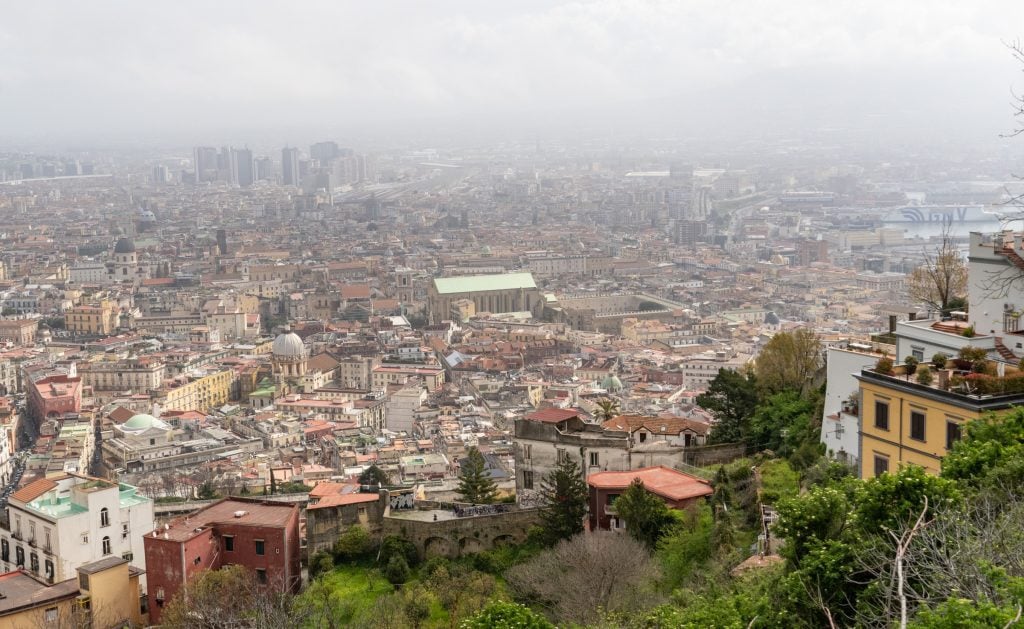
Take in the View from Castel Sant’Elmo and Vomero
For a different side of Naples, check out the Vomero neighborhood — while the name might cause you to blanche for a moment (no? Just me?), it’s actually the fanciest and ritziest neighborhood in Naples. Located on Vomero Hill, far above the city center, it’s a beautiful place to take in the views over Naples, Mount Vesuvius in the background.
You can explore the castle and its star-shaped military fortress. It’s been in action since the 13th century, and it has a hell of a lot of history! You can buy skip-the-line tickets here.
To get to Castel Sant’Elmo, take the funicular to Morghen station and walk. I highly recommend taking the funicular up and walking your way down afterward. (Though be sure to wear closed-toe shoes — I stepped through a surprising amount of broken glass on the stairs down from the castle.)
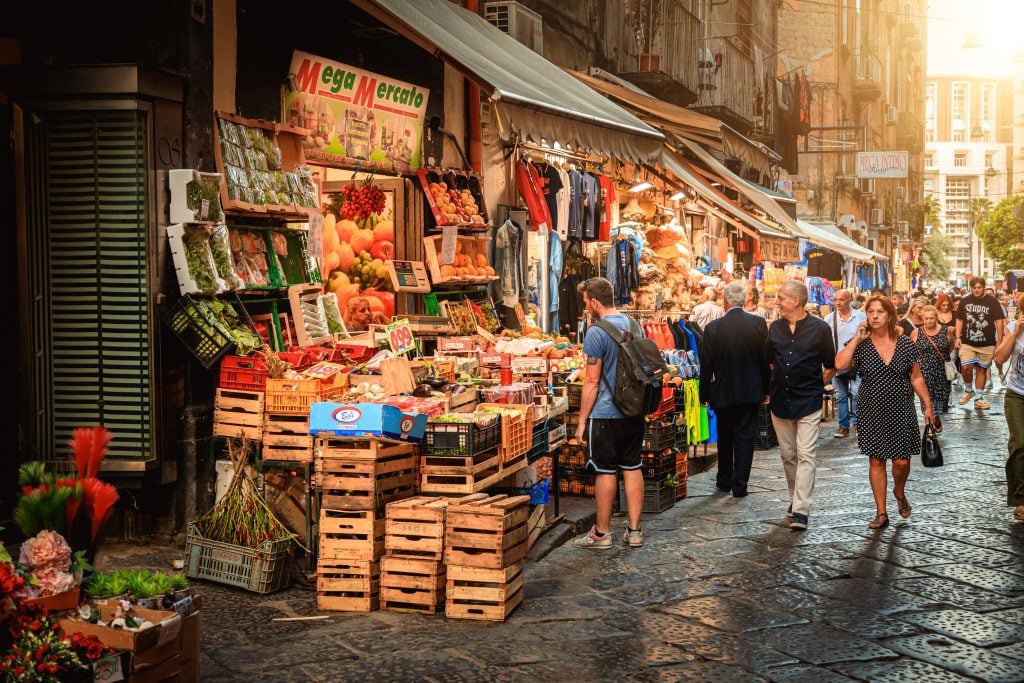
Go on a Street Food Tour
No matter where you are in Italy, the food will be good — but the food culture in Naples one of my favorites in the country. Naples is one of Italy’s historic food capitals, and the locals know how to prepare a fresh meal, so you cannot go wrong with a street food tour.
This food tour stops at all of the hot spots – basilicas and main squares – along with out-of-the-way stops that add a unique flavor to the mix. Participants will sample traditional dishes while getting an entertaining education into the history of the city as you visit cultural attractions in between bites.
Come hungry, because while you’ll only be sampling the dishes, there’s a lot of ground to cover! Ragù, baccalà, and pizza are just scratching the surface, and vegetarian options are available everywhere. Prices for this tour start at 42.50 EUR ($45.90 USD).

Take a Cooking Class
If your foodie style is more hands-on, a cooking class is really the best way to immerse yourself in Italian culture. So what will it be? Pizza or pasta? Why not do both?
You may think you know how to make pizza from scratch, but this Neapolitan pizza class teaches you the well-kept Italian secret of doughmaking, passed down through the generations. The art of pizza-making is an emotion, and a master pizza maker will show you how to feel it. Then you can indulge in your creation, complete with an appetizer and drink.
The fettuccine and ravioli option involves the intimate act of small-group pasta making. Set in a historic restaurant in Naples, it includes fresh local products like mozzarella, cured meats, produce, and yes, of course you will be eating your creations here as well! Prices start at 44.50 EUR ($48 USD).
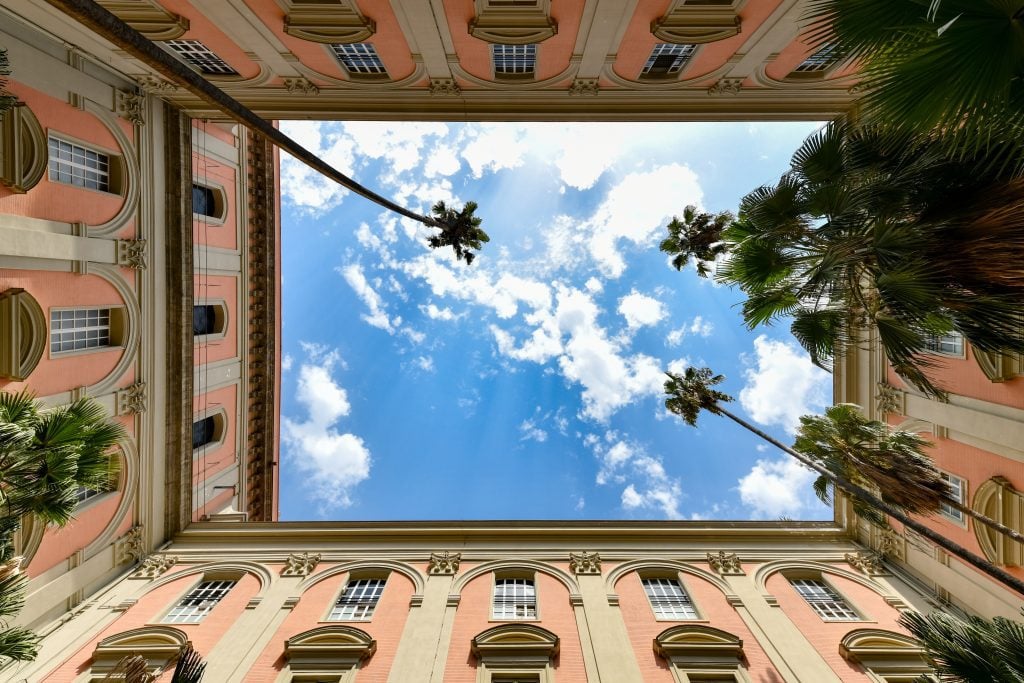
Naples National Archaeological Museum
Visit Naples’ National Archaeological Museum to get an intriguing peek into ancient life. There you will see artifacts rescued from Pompeii and Herculaneum, plus magnificent Greek and Roman sculptures and mosaics spanning millennia of history.
This neoclassical museum boasts an expansive collection that includes ancient Egyptian relics. Egyptology exhibits are particularly popular, and you’ll find seven rooms dedicated to Egyptology – covering themes like power, social structure and death.
The National Archaeological Museum in Naples is an essential stop on any trip, and can often become overrun during weekends and peak season.
To ensure you can fully experience it during your stay, book skip-the-line National Archaeological Museum Naples tickets beforehand to ensure maximum enjoyment! Admission is 22 EUR ($23.50 USD) and tickets are valid for two consecutive museum days.
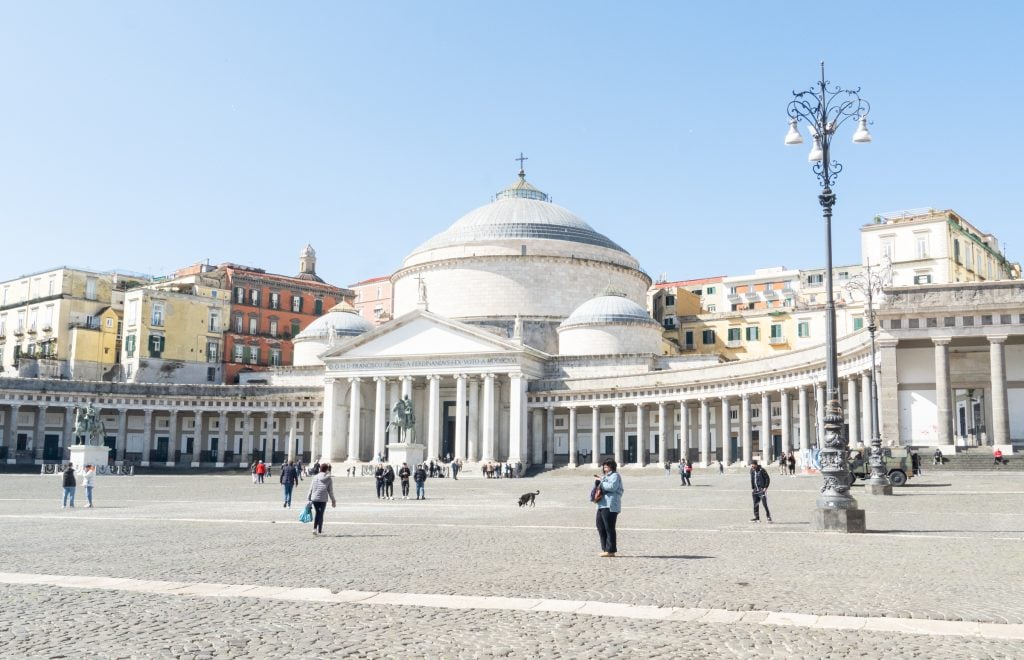
Piazza del Plebiscito
The Piazza del Plebiscito is one of Naples’s grandest squares. It was named to honor an 1861 plebiscite that united Italy from two separate realms into one nation-state — specifically, the Bourbon Kingdom of Two Sicilies merging into the Kingdom of Italians.
It is also one of the most beautiful spots in all of Naples, playing host to a number of cultural events throughout the year. When you arrive, you may notice two impressive buildings: at one end of the square is San Francesco di Paola Basilica, a wonderful Neoclassical structure and one of Naples’s largest churches.
On the other end is the Royal Palace of Naples, a real monument to the city, thanks to its expertly preserved state. For a short while in the 1960s the square was sadly used as a car park, but today is now strictly pedestrian and a great place to escape the traffic of Naples.
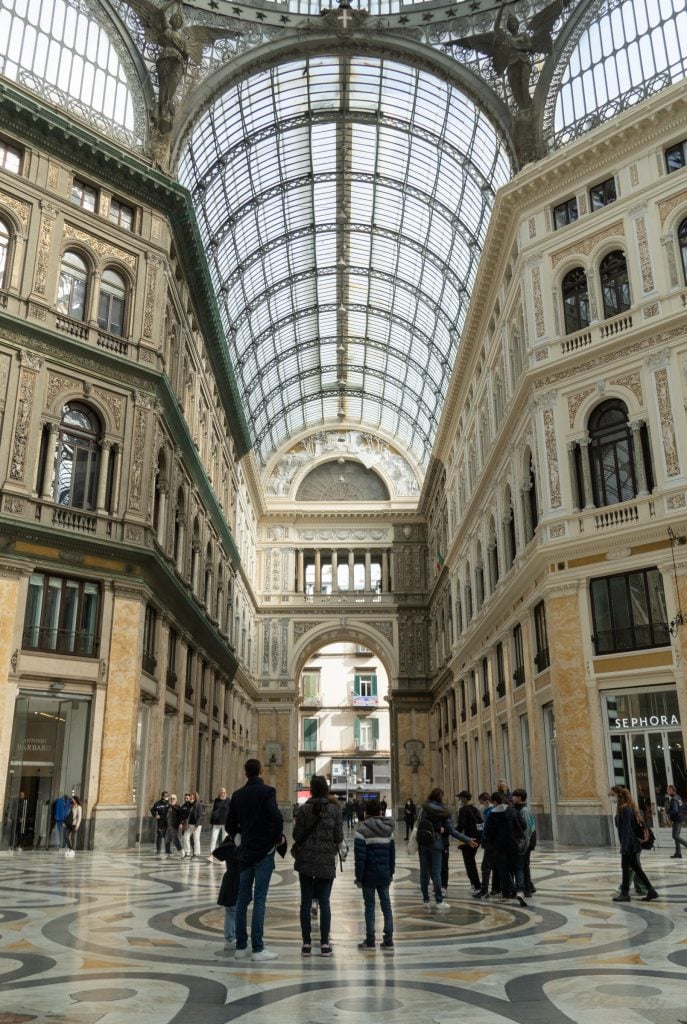
Galleria Umberto I
Located in a vibrant area of downtown Naples, Galleria Umberto I is an exquisite shopping center that also doubles as an art installation, similar to Milan’s Galleria Vittorio Emanuele II. Here you can explore various collections, such as Italy’s second-largest Egyptian collection.
It all started back in 1887 (pretty recent by European standards!) by the will of King Umberto I, a mere nine years after the Galleria Vittorio Emanuele in Milan. With an arching dome reaching 184 feet high, the arcade takes on a criss-cross shape, with a gorgeous mosaic of the zodiac on the center floor.
There are four entrances and plenty of shopping to be had, along with cafés and restaurants. Admission is, of course, free. However, you’ll still need your wallet for all of the purchases you’ll make!
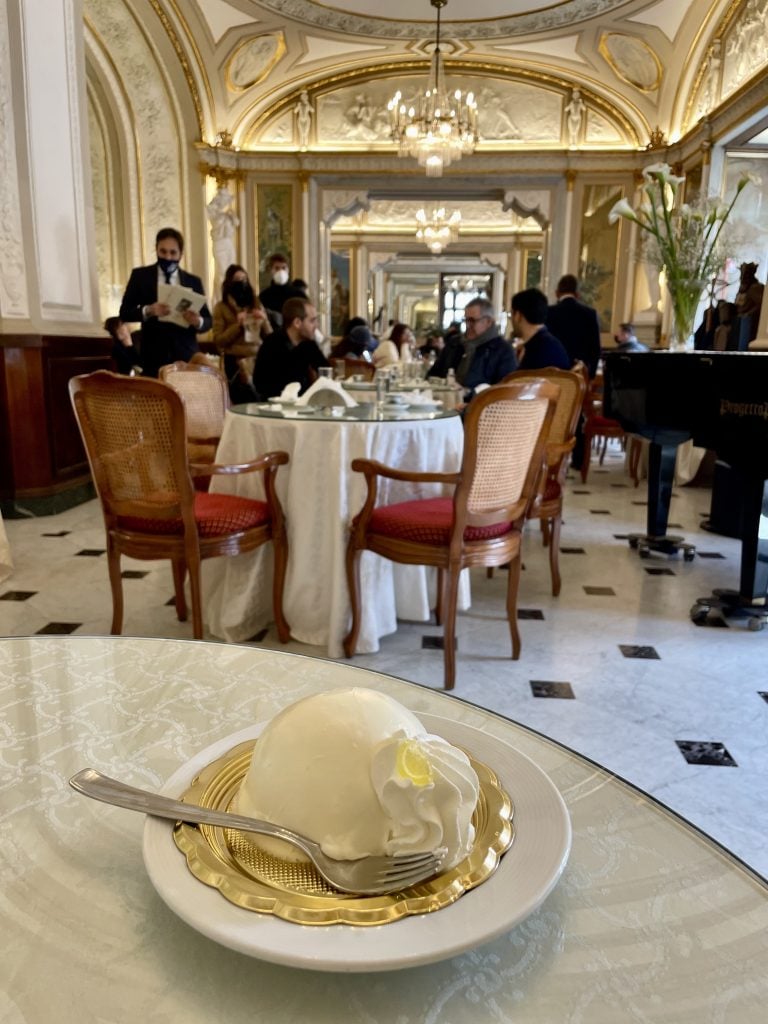
Have Fancy Pastries at Gran Caffè Gambrinus
I love visiting elegant cafes throughout Europe — but I was surprised to learn that one of the best was in Naples! Gran Caffè Gambrinus is located right on Piazza del Plebiscito and feels like another world. You walk into the cafe and are spellbound by its crenellated walls with gold trim, statues on display in the alcoves.
And a fancy cafe deserves a fancy pastry. I highly recommend trying a delizia del limone, a special cake from the Campania region that is filled with and topped with lemon custard.
Pair it with any of the fancy, ornate coffee drinks. Somehow I ended up with a drink that was a shot of espresso between multiple layers of thick cream, topped with pistachios.
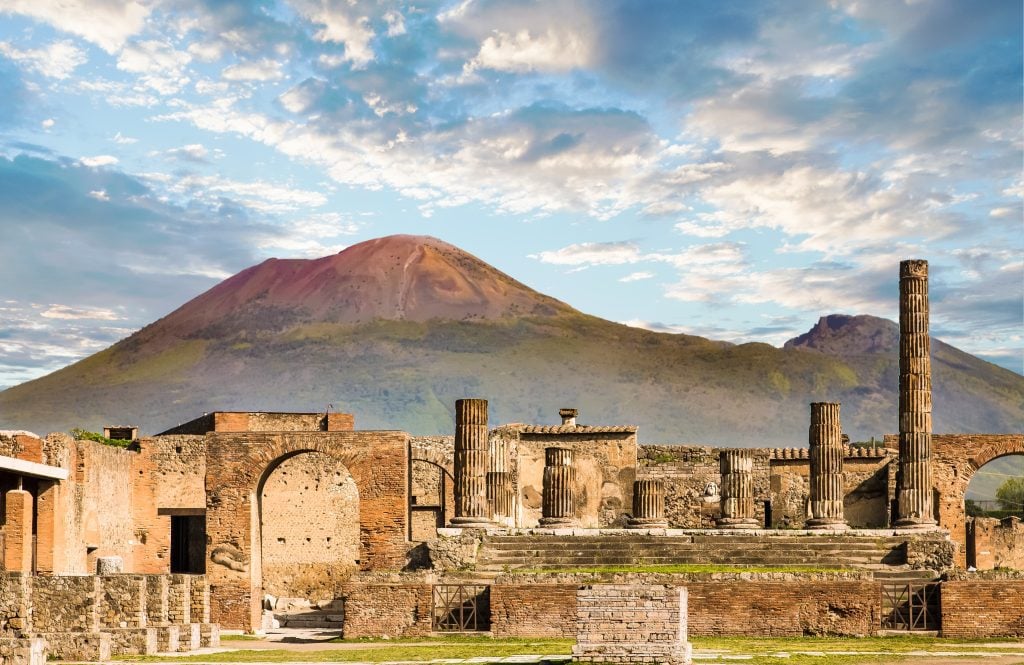
Visit Pompeii (and/or Herculaneum)
In the year AD 79, Mount Vesuvius exploded, burying the city of Pompeii in ash and preserving it for centuries since. If you’re a fan of ancient history, Pompeii is one of the ultimate destinations for you, in Italy or worldwide — it’s rare to see a city so well-preserved to this day.
Pompeii is located close to Naples and makes an easy and fascinating day trip. It can also be surprisingly moving, seeing plaster casts of bodies in their last moments of life.
Near Pompeii is Herculaneum (Ercolano in Italian), which is another site worth visiting. It’s smaller than Pompeii (and easier to get around on foot if you have limited mobility), and in some ways is better preserved thanks to being closer to the volcano and being excavated more recently.
You have a few options for visiting Pompeii from Naples:
This tour from Naples includes Mount Vesuvius and Pompeii, which are cool to visit back to back and have the historical context.
This tour from Naples includes both Pompeii and Herculaneum, giving you a taste of both sites.
This tour from Naples includes Pompeii, lunch, and wine tasting, a fun way to do a lot in a half-day tour.
If you want to visit Pompeii independently, you can take the train from Naples to Pompeii on the Circumvesuviana Line, which takes about 37 minutes. For Herclaneum, take the train from Naples to Ercolano, which is a bit further.
If you take the train to Pompeii, I highly recommend taking this tour of the ruins with an archaeologist, which has long been one of the best-rated tours in the Bay of Naples!
Remember to bring a water bottle and sun protection, including a hat and long-sleeved shirt or jacket — these ancient sites can get especially hot in the summer months, and there isn’t much shade.
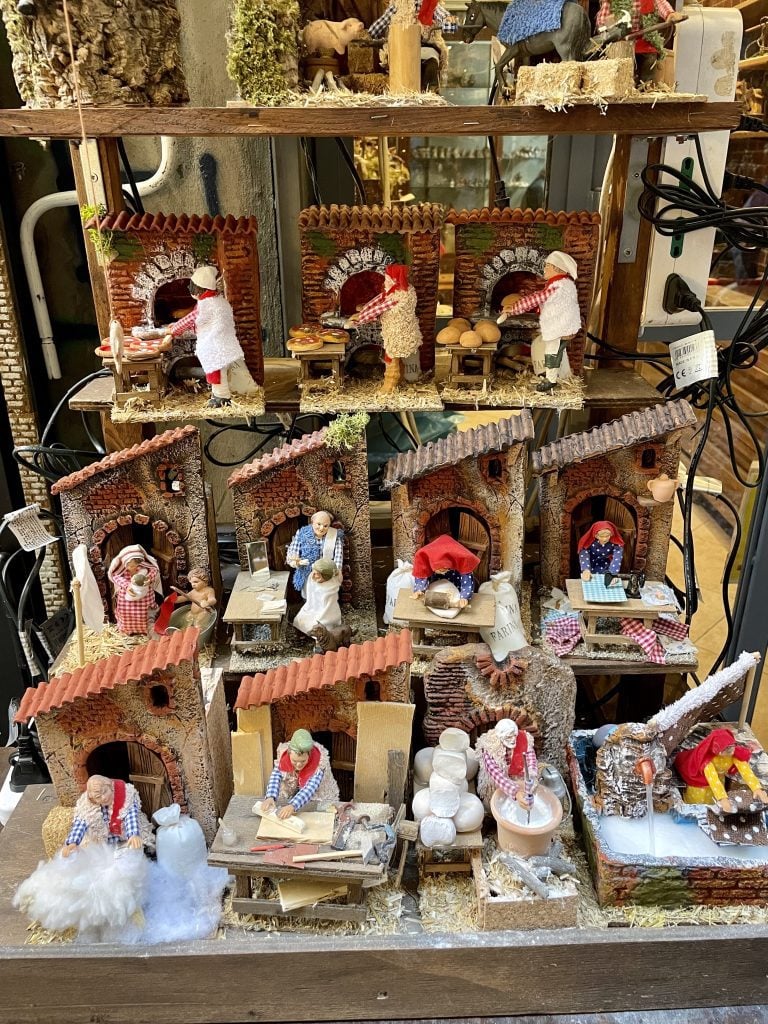
Gawk at Nativity Scenes on Via San Gregorio Armeno
Naples’s historic center is a wonderful place to get lost — but whatever you do, find your way to Via San Gregorio Armeno. This little street, located between the main thoroughfares of Spaccanapoli and Via dei Tribunali, is home to hundreds of nativity scenes.
These scenes, called presepi in Italian, contain all kinds of figures — and they’re all for sale. Of course you can find baby Jesus and camels, but here in Naples you can find a pizza-maker figurine! Because we all know they were having margheritas at the birth of Jesus!
Anyway — this street is an unmissable place in Naples, and if you know anyone who collects nativity scenes, these figurines make the perfect gifts.
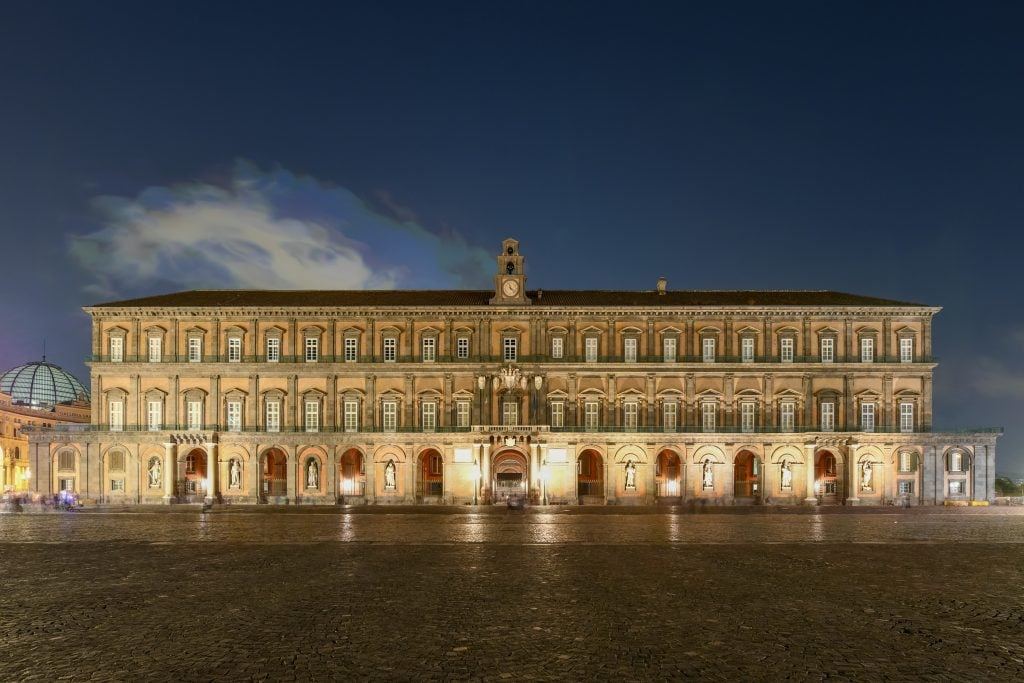
Royal Palace of Naples
At the heart of Naples lies the Royal Palace, known by locals as Palazzo Reale. Take a guided tour to appreciate its beauty and history – from the apartments of Royal Families to its grand court theater featuring tapestries, marble sculptures and frescoes adorn its walls.
Discover how the rich and famous lived in Naples at this lavish palace that has been carefully preserved as it was when used by royal families. Step inside the throne room, imagine operas or plays being staged at its private theatre, or simply stroll through lavish rooms adorned with antique furniture and art.
Explore Spaccanapoli Street to reach the Gesu Nuovo church and admire its gorgeous interior as you stroll to its lovely cloister – Caravaggio has painted three of his iconic paintings here: Seven Acts of Mercy in Gesu Nuovo church, Flagellation at Capodimonte National Museum, and The Taking of Christ at Sansevero Chapel. Admission is 10 EUR ($11 USD).
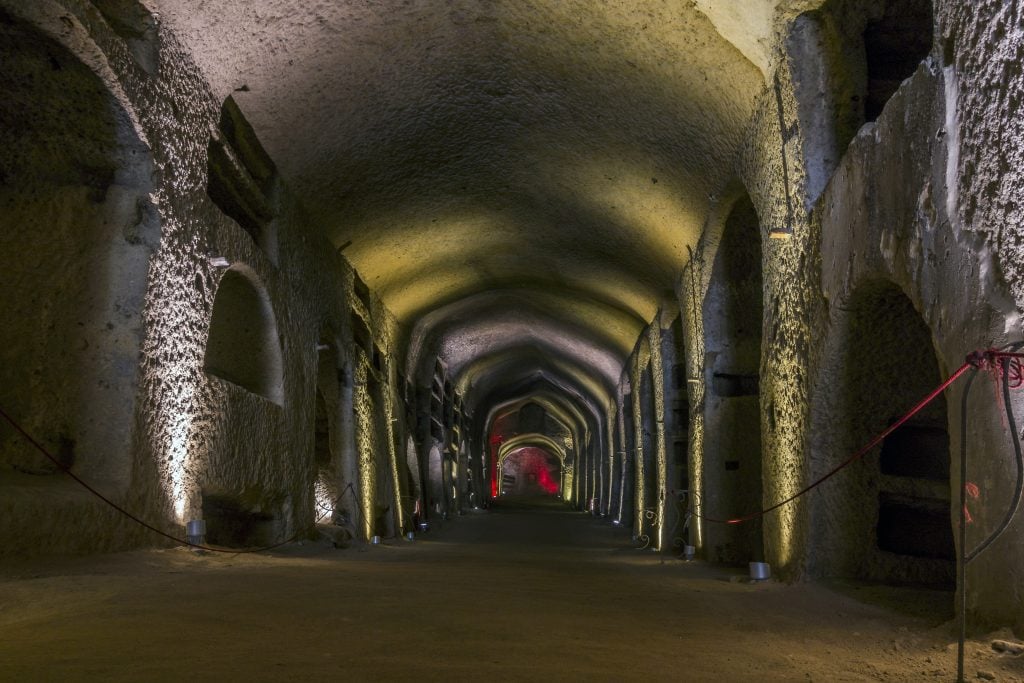
San Gennaro Catacombs
To gain some insight into a rich culture of death, the catacombs will more than satisfy. Here you will discover San Gennaro’s tomb, where his remains were brought for transference as the patron saint of Naples.
The Naples Catacombs is one of Italy’s most unusual attractions. These burial sites of early Neapolitan Christians offer an eye-opening underground world, complete with rooms cut into rock faces and decorated with 2nd century frescoes from churches like San Gennaro (also known as Faccia Gialla, or Yellow Face). One tomb in particular stands out, which may contain one of his oldest depictions — it could even contain his face itself! To find out, you’ll just have to come see it for yourself.
Visit the highlights with ease by taking a guided tour, held every hour (at extra cost). Regular admission is 17 EUR ($18 USD); for students, seniors, and groups of 20 or more, it is 13 EUR ($14 USD) per person. You can get your tickets here.
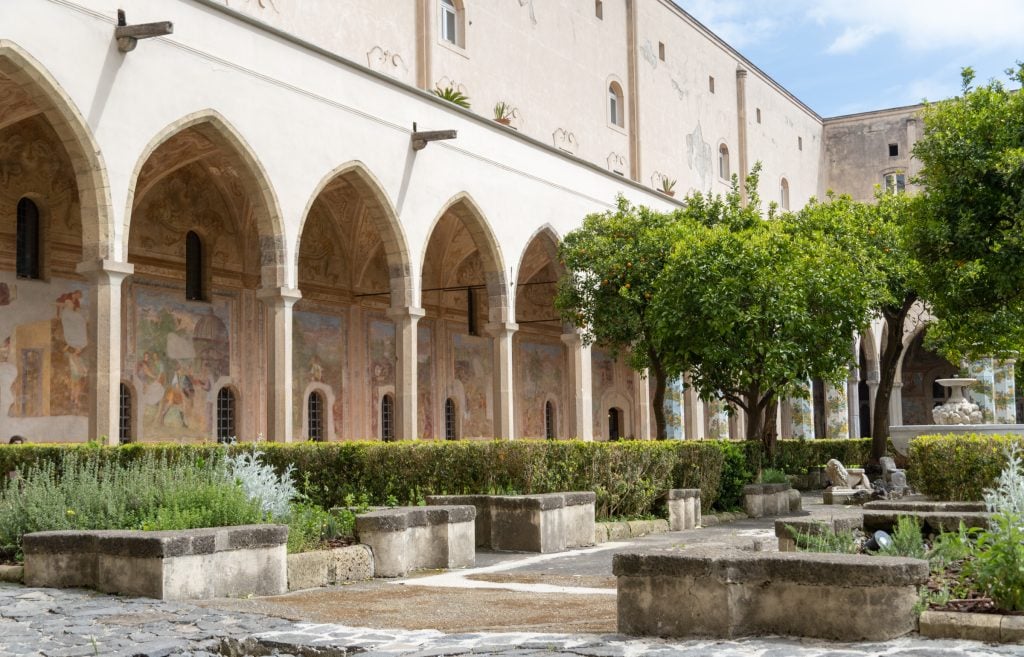
Chiostro di Santa Chiara
Tucked away behind a 14th century church, the Cloister of Santa Chiara is an impressive monastery with an intriguing backstory. Originally built to house 200 monks and the tombs of the Angevin royal family, it was disregarded as a lowly stable by the son of the builder. As a result, it received an exquisite baroque makeover years later.
A major draw for visitors, it may well be the most photographed spot in Naples. In fact, the Santa Chiara itself was only built in the 18th century, and both church and monastery suffered bomb damage in WWII (which has since been renovated.) Of particular note are the majolica-tiled benches and ornate pillars that line the paths.
Look out for the ceiling fresco and luxurious interiors and make sure to view its three presepi (Christmas crib scenes) circa the 1700s. These elaborate tableaux are one of the city’s signature features – perhaps the most elaborate in all of Italy. Admission is 6 EUR ($6.50 USD) and 4.50 EUR ($5 USD) for teachers, students, and seniors over 65).
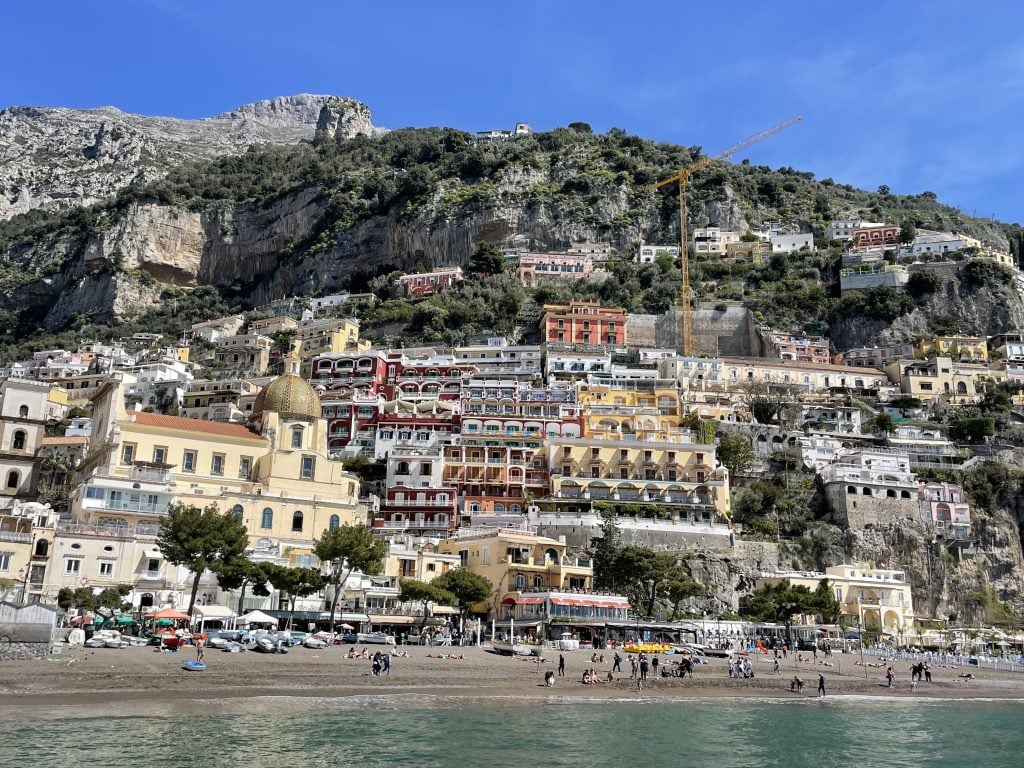
Visit the Amalfi Coast
The Amalfi Coast is one of the most spectacular places to visit in Southern Italy. And one of the best things to do in Naples is to head to these stunning cliffside towns for a day!
To get the most out of a day to the Amalfi Coast, I recommend visiting the towns of Positano and Amalfi — two towns that are gorgeous, easy to get to (by Amalfi Coast standards), and pack a lot of value into a single day.
First off, you can take a tour from Naples to the Amalfi Coast that includes visits to Positano, Ravello, Amalfi, and lunch overlooking the sea in Conca dei Marini. This is the easiest option, and a great way to relax and enjoy yourself.
Want to do it more independently? You can take a ferry from Naples to Positano (or, alternatively, Naples to Amalfi), and explore those towns on your own. You can’t beat the ferry views!
You can also book a private transfer from Naples to the Amalfi Coast. This is more expensive, but door-to-door experience can be worth it, especially if you’re splitting it between a few travelers.
And for the cheap option? Book a bus from Naples to Positano via Sorrento. Just know that you get what you pay for, and this can take a while.

Have a Sfogliatella for Breakfest
Italy may be my favorite foodie destination in the world — but not for breakfast. I feel like Italy goes light on breakfast (usually just a cornetto and caffe, or another light pastry) so they can throw all their energies into the other meals.
But Neapolitans know what’s up — they eat sfogliatelle for breakfast. Known as lobster tails in the US, these are long, curved pastries with layers upon layers of flaky pastry, wrapped around ricotta cream. Sometimes the cream is enhanced with orange, cardamom, candied lemon peel, or almond paste.
So if you’ve been looking for an excuse to indulge in your breakfast, grab yourself a sfogliatella in Naples!
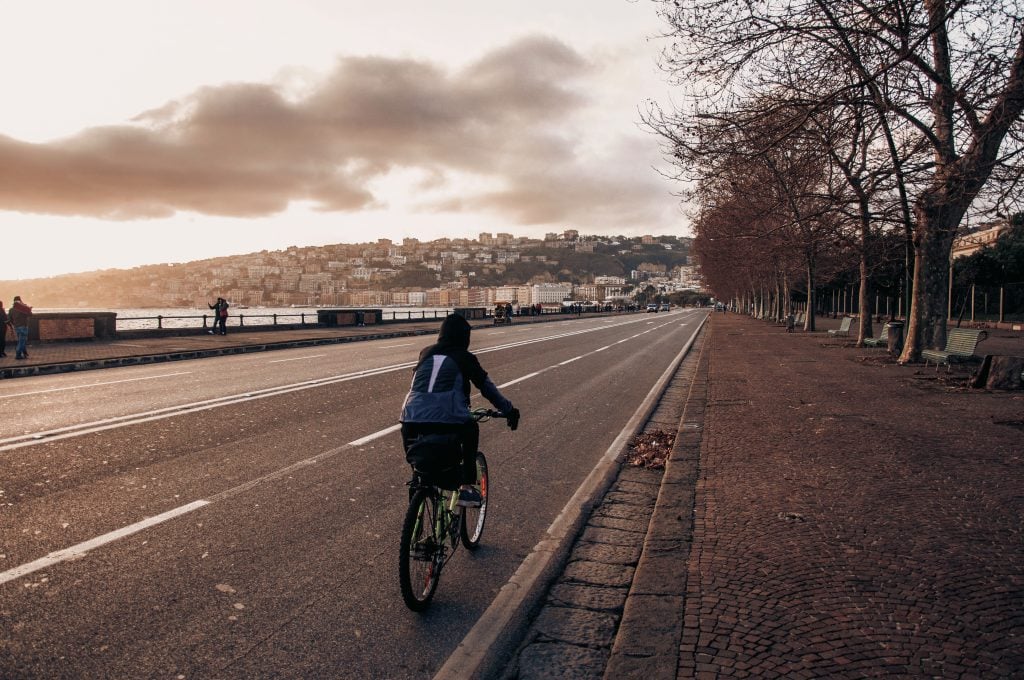
Wine, Food and E-Bikes
Leave the city behind, if only for a few hours, and explore outside Naples effortlessly on two wheels with an e-bike food and wine tour! You will ride through the gorgeous Phlegrean Fields with your informative guide on this e-bike tour.
Travel along the coastline, passing ancient ruins along the way to Lake Averno, a volcanic site where you will stop and enjoy lunch and a wine tasting on the shores of the lake. This is a relaxing change of pace from the bustle of Naples! Alcoholic beverages are available for those who wish to partake. Prices start at 77 EUR ($83 USD).
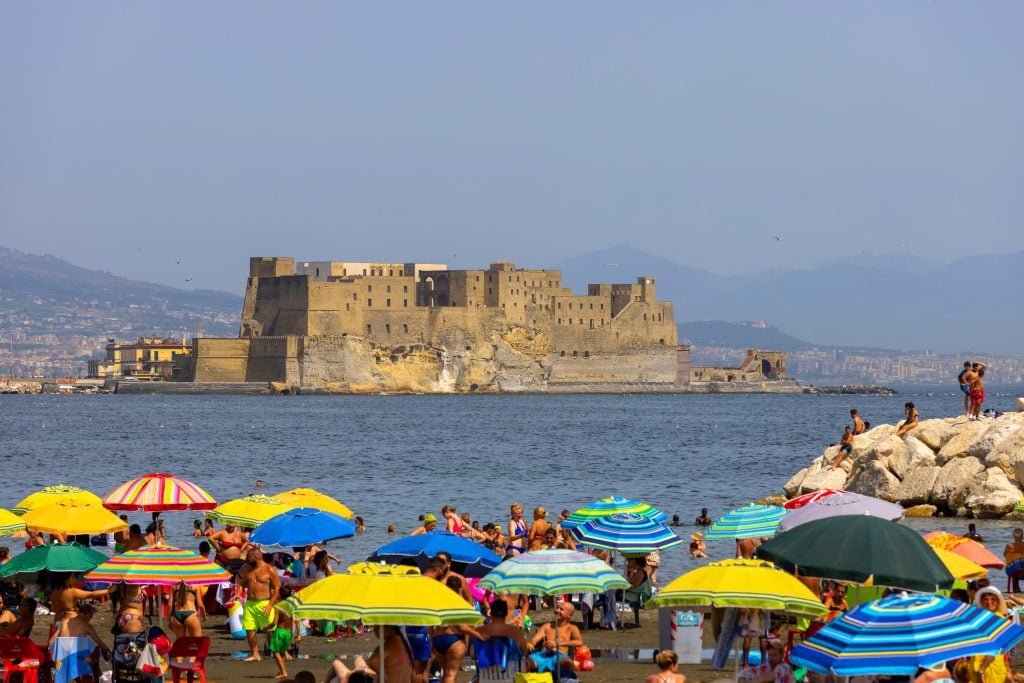
Castel dell’Ovo
Castel dell’Ovo (roughly translated to “Egg Castle”) is one of Naples’s iconic landmarks and an intriguing destination to visit for both its story and architecture. Legend holds that Roman poet Virgil placed an egg into its foundation as part of an agreement, declaring if ever broken, so too would both Naples City and Castle dell’Ovo become unsteady structures.
As soon as you arrive at a castle, make sure to venture inside to explore its lavish interiors. There’s much to see – including an extravagant church featuring frescoes and gold decor – including a cavernous church that’s almost surrealistically lavish in size and decoration.
Located right on the coastline, the Castell dell’Ovo can be an imposing structure as seen from the water, with Mount Vesuvius in the background. In fact, it is the oldest standing fortification in Naples. Today, it is used for temporary art exhibitions and events. And that’s not all — it’s one of the free things to do in Naples Italy!
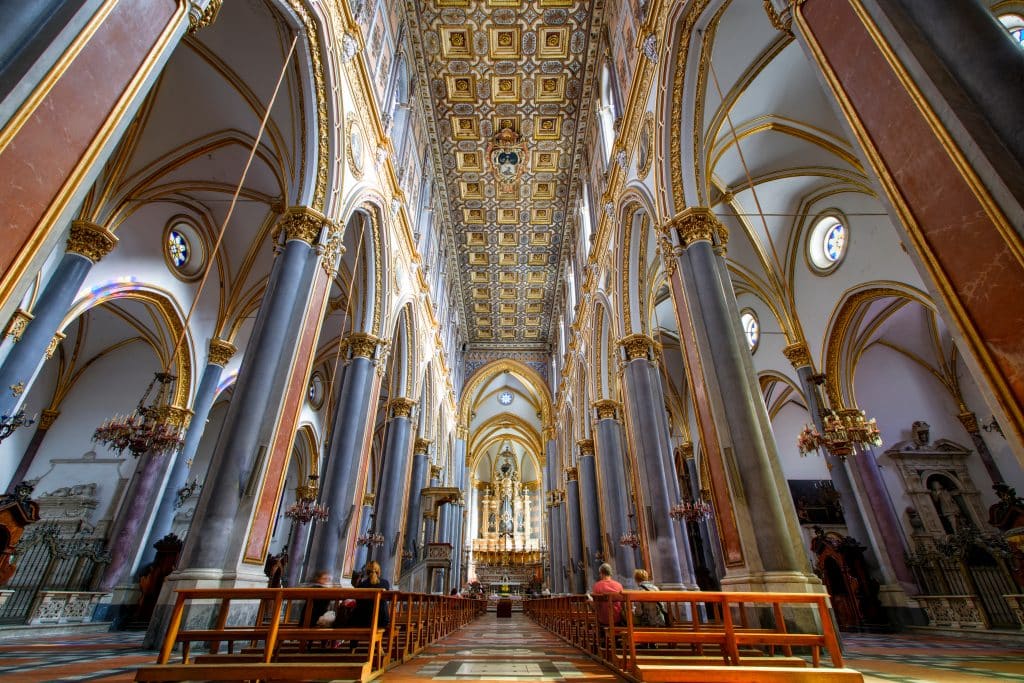
Basilica San Domenico Maggiore
Basilica San Domenico Maggiore should also be on your itinerary; this church in Naples’ central district stands as one of its most impressive landmarks. It features Gothic architecture with three-sided palazzi, including an impressive double staircase, Cappella Royale that houses an 18th-century Nativity scene and some incredible artwork pieces inside its walls.
While the exterior may seem interesting, if not a tad austere, once you enter, the interior will blow you away. Opulently decorated with intricate gold detail and tall columns, it is filled with sculptures and paintings.
Be sure to pop into the Capella Brancaccio to see some of the church’s original frescos from the 14th century. Admission is free, but there are various guided tours starting at 5 EUR ($5.50).
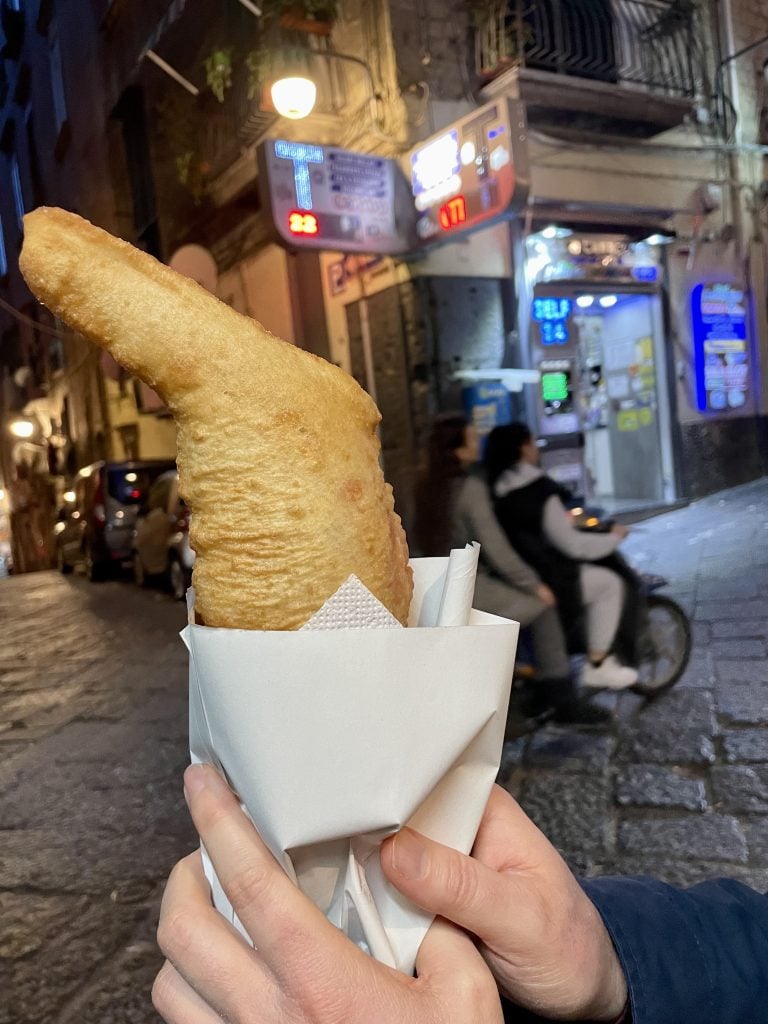
Try a Pizza Fritta
If you haven’t been pizza’ed up to your eyeballs yet, go a step further and try a pizza fritta (fried pizza)! Nope, this isn’t deep-fried slices of pizza like you’ll find in Scotland — this is more like a piping hot calzone.
Pizza fritta is similar to the panzerotti you’ll find in Puglia, with a thin dough shell that is deep fried and crispy on the outside (rather than the doughier Sicilian-style panzerotti), filled with tomato sauce, mozzarella, and sometimes other fillings. It’s a decadent snack and one that you should try at least once.
Best of all, you can find pizza fritta all over the historic center and the Quartieri Spagnoli, and it won’t cost more than a few euros. It makes a GREAT late-night snack after a few cocktails!
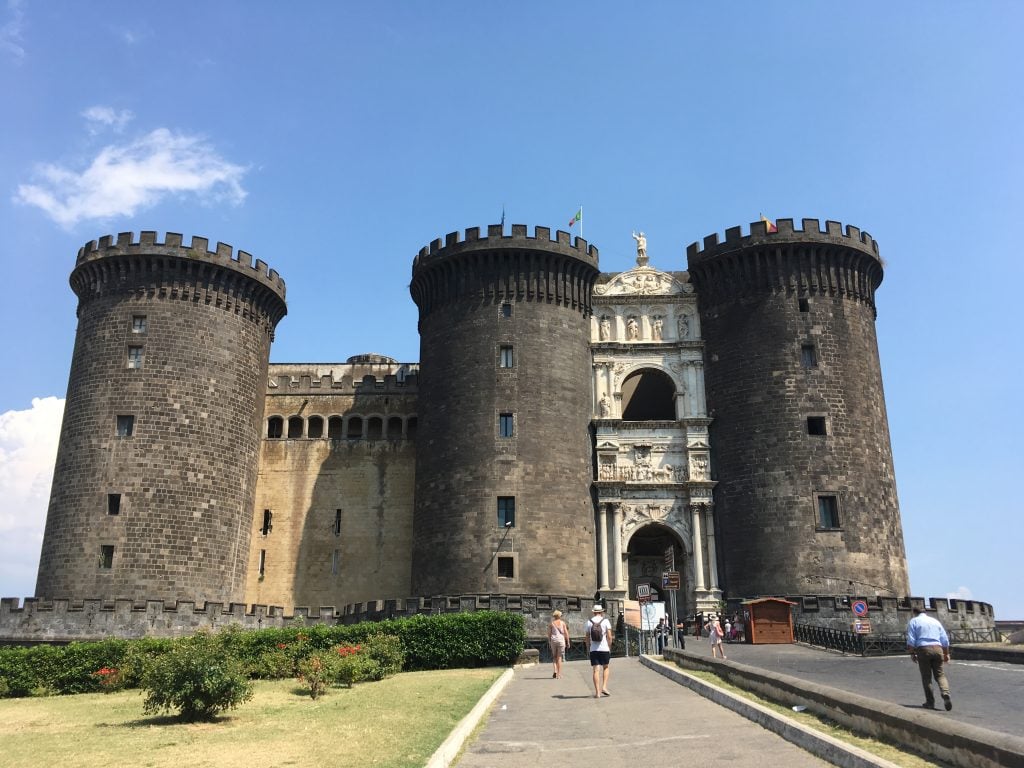
Castel Nuovo
For over eight centuries, the Castel Nuovo has been one of Naples’s iconic landmarks and an absolute must for history enthusiasts. Facing the Mediterranean, the Castel’s majestic walls create an unforgettable view, while its towering structure houses both a Municipal Museum and a local history exhibit.
The collection showcases art from both the Neapolitan Renaissance and Baroque periods, such as works by Battistello Caracciolo, Luca Giordano and Francesco Solimeno. Also, be sure to visit Palatine Chapel and Armoury Hall while at the palace. Many myths and legends surround this ancient structure, just one of which is the “Prison or Pit of the Barons.”
These are four secretly stored coffins with no inscription that contains mortal remains. It is thought that they are nobles who had participated in the Barons’ conspiracy of 1485. But who knows? The only way to find out is to visit. Admission is 6 EUR ($6.50 USD).
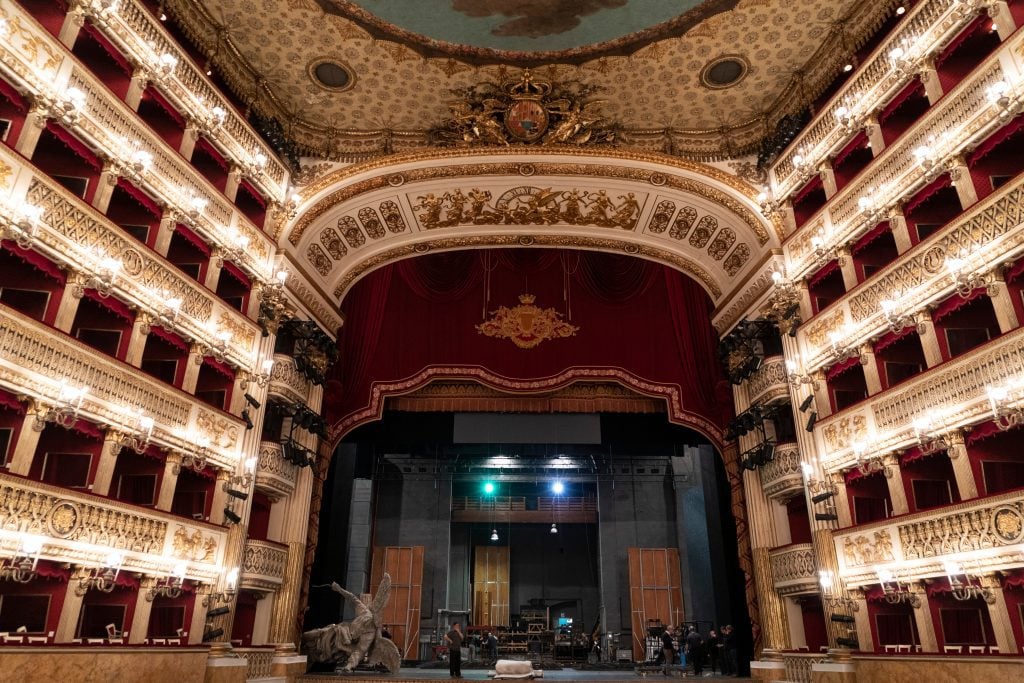
Teatro di San Carlo
Naples’ oldest opera house, a UNESCO World Heritage site, should not be missed. It features stunning ceiling frescoes decorated in luxurious red and gold, and horseshoe-shaped auditorium seating arrangements. It is one of Italy’s premier opera houses and offers both classical and contemporary performances year-round. Ideal for culture seekers visiting Naples!
This theater opened its doors in 1737 and has seen some iconic opera and musical performances take place there including Christoph Willibald Gluck’s 1852 Clemenza di Tito and Johann Christian Bach’s 1761-62 Alessandro nell’indie, written by Bach himself! You may purchase additional tickets (when available) to explore its historical hall, boxes and foyers of this theater.
Apart from regular performance tickets, which start at 20 EUR ($21.50 USD), you may purchase guided tour tickets for 9 EUR ($9.70 USD) to explore its Main Stage Hall, Royal Box and Foyers of this theater. Tours are in English and Italian.
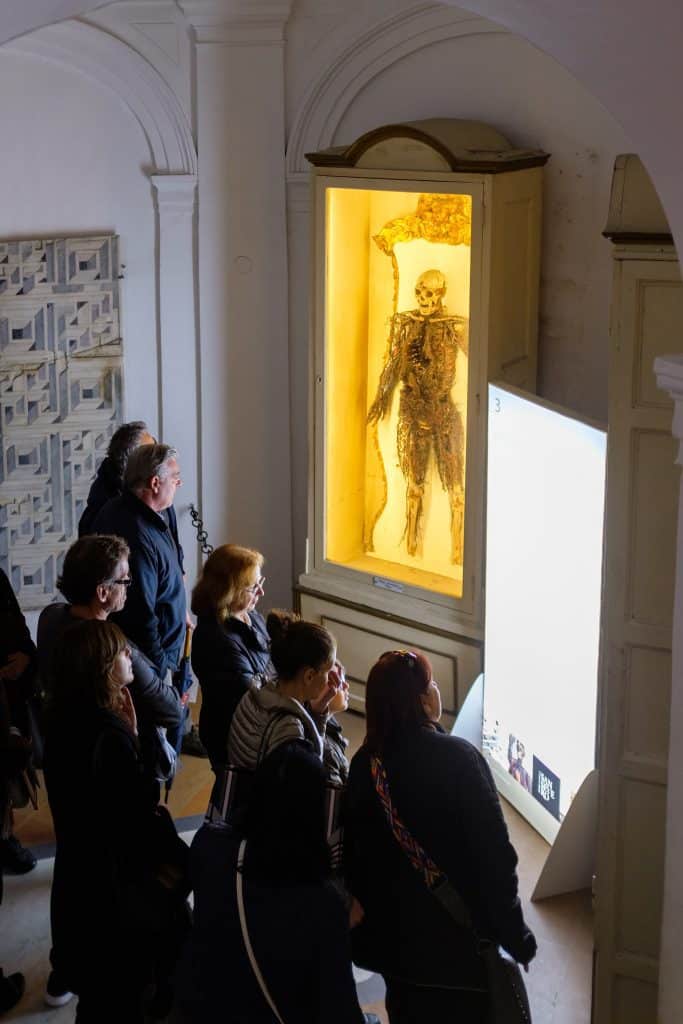
Museo Cappella Sansevero
Museums and churches throughout Rome are an impressive spectacle to behold, including Museo Cappella Sansevero with its celebrated Veiled Christ – one of the crowning achievements of Rococo architecture combined with religious symbols and motifs.
The entrance to the Museo is unassuming, as if it wants to keep the secret of the treasures just past the threshold. Once past its deep olive doors, the softly illuminated interior leaves you spellbound by the mystery and dramatic air that permeates this space. Step into the chapel and be transported to a time long past.
The Statues of the Virtues are particularly impressive. Take in the grandeur of intricate sculptures representing the virtues of Education, Self-control, Liberality, Marital Sweetness, and Modesty, to name a few. They are meant to represent the different stages on the path to enlightenment. But ornate sculptures only scratch the surface of what this amazing museum has to offer.
Admission is 10 EUR ($10.80 USD) and 7 EUR ($7.50 USD) for young people up to 25, as well as physically-challenged visitors and their handlers (who can enter on just one ticket.)
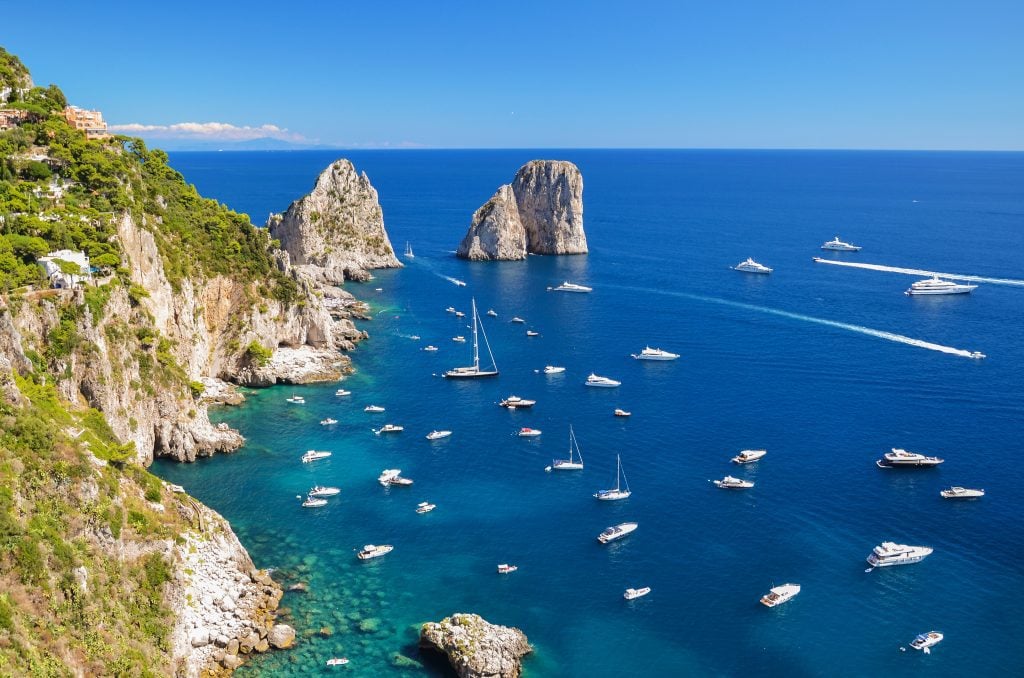
Visit Capri
The island of Capri holds a magic all its own. Known as the “island of a thousand faces,” Capri features rocky cliffs along crystalline waters and a vibrant city with a lively piazzetta tailor-made for high-end shopping and people-watching.
You can take the ferry from Naples to Capri yourself, which is a 50- to 70-minute journey depending on the ferry. See the full ferry schedule and book here; I recommend booking ahead of time in high season.
You can also take a full-day tour that begins with an exhilarating jetfoil ride from Naples to Capri. Then, take in the views as you traverse Mamma Mia road before stopping in Anacapri for a little shopping. From La Piazzetta, ride the furnicular to Marina Grande and take in the natural wonders of the Blue Grotto.
As the day winds down, return to your pick-up point by jetfoil. It’s an action-packed day of natural beauty and authentic Italian island life that you can’t quite get in Naples. Prices for the tour start at 162 EUR ($175).
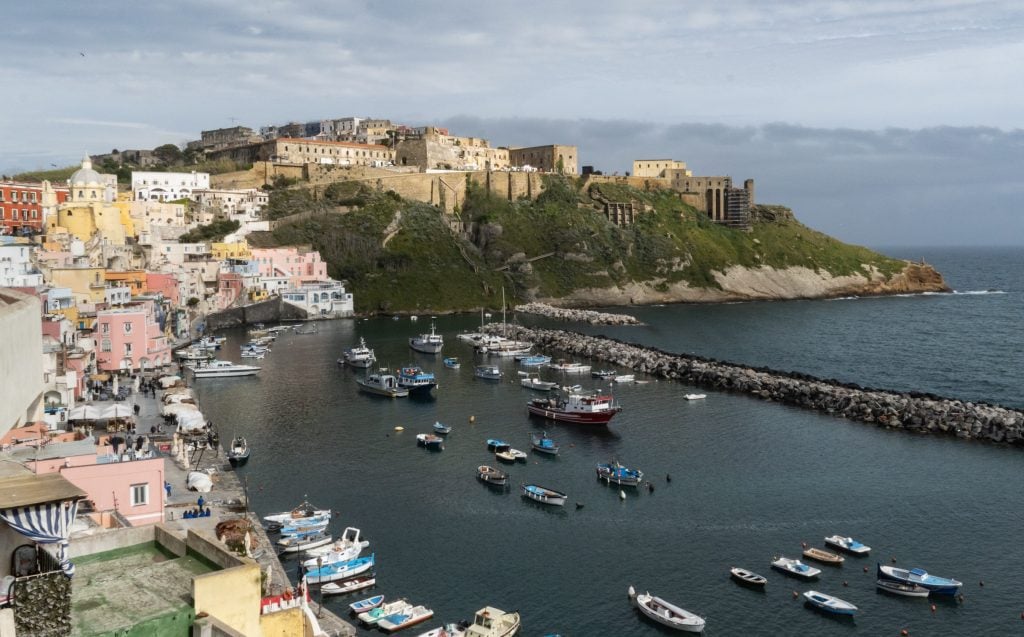
Visit Procida
Of the three major islands in the Bay of Naples — Capri, Ischia, and Procida — Procida is the closest to Naples, the smallest, and the least well-known. If you’re going to do any island day trip, Procida makes a great choice!
Procida is home to one of the most colorful harbors in Italy — seriously, it puts Cinque Terre to shame — and it’s a lovely, laid-back place. It makes a pretty fantastic foil to Naples! And I love that it’s small enough to get around the whole island on foot.
I happened to be in Procida on the day it was declared Italy’s Capital of Culture in 2022, and the entire island erupted in a colorful celebration. What a time to visit!
You can take the ferry from Naples to Procida yourself, which is a 30- to 60-minute journey depending on the ferry. See the full ferry schedule and book here; I recommend booking ahead of time in high season.
Want the easier option with swim stops? Book a boat tour to Procida that includes lunch. Alternatively, you can do a combination trip to both Procida and Ischia from Naples.
A word to the wise: take a motion sickness pill if you’re taking the fast hydrofoil. The car ferries are much slower and more stable.
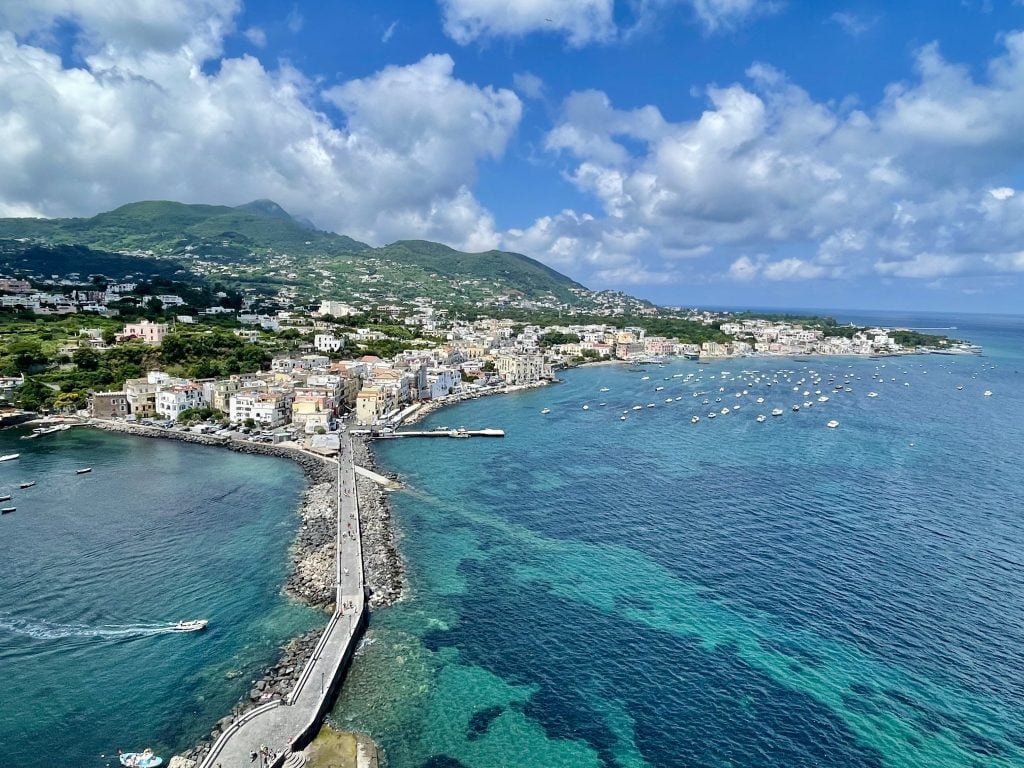
Visit Ischia
Ischia is the largest of the three islands in the Bay of Naples — and a bit of an enigma. While enormously popular with Neapolitans looking for a summer getaway, Ischia isn’t nearly as popular with international travelers, which gives it a much more feel.
Ischia is one of my favorite islands in Italy. It reminds me a bit my beloved Koh Lanta in Thailand — the development is kept at a reasonable level, which keeps it from turning into a madhouse (or overpriced Capri).
You might know Ischia from Elena Ferrante’s Neapolitan novels — a pivotal scene from My Brilliant Friend happens on the beach in Ischia!
Aside from the beaches in Ischia, you can enjoy the hot springs (including some lovely hot springs resorts like Negombo), enjoying the views from the Castello Aragonese, hiking up to Mount Epomeo, and eating local rabbit (for an island, they sure enjoy their inland food!).
You can take the ferry from Naples to Ischia yourself, which is a 50- to 90-minute journey depending on the ferry. See the full ferry schedule and book here; I recommend booking ahead of time in high season.
Up for a tour? You can book a boat trip to Ischia from Naples, complete with lunch. Want a bit more? Book a combination trip to both Procida and Ischia from Naples.
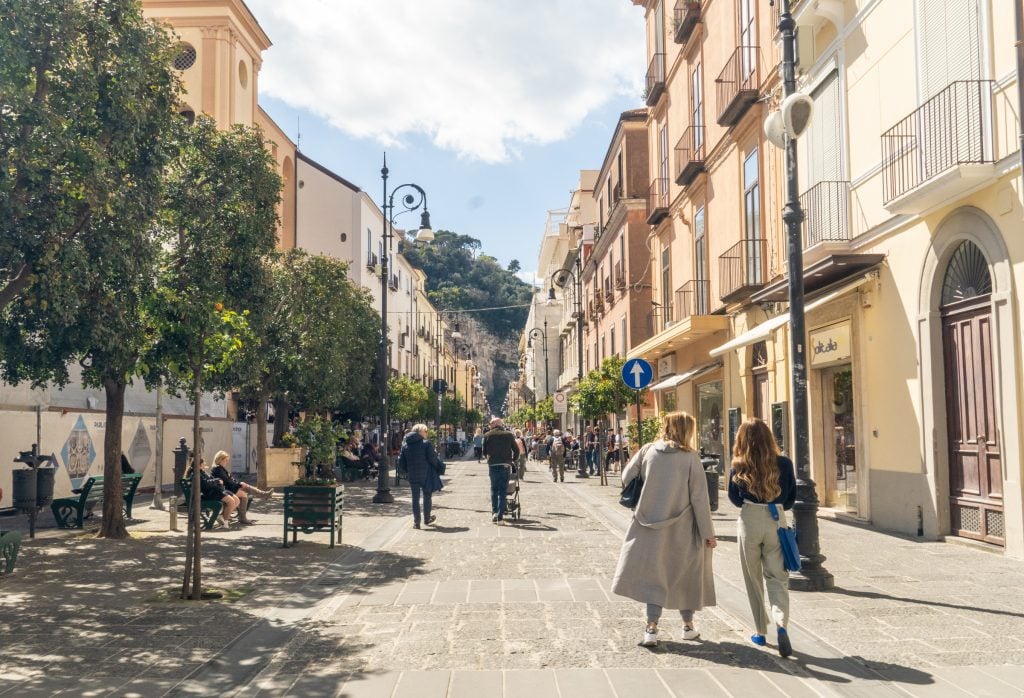
Visit Sorrento
Sorrento is one of the most popular tourist towns on the Bay of Naples. In fact, it’s perhaps more famous to be used as a base to visit the other, more spectacular surrounding destinations, like Positano and Capri.
But if you want to explore a pretty and chilled out town, Sorrento makes a lovely day trip from Naples. Spend your day walking the colorful streets, having fish by the seaside in Marina Grande, or tasting Sorrento’s finest local limoncellos.
The best way to get from Naples to Sorrento is to take the Campania Express train from Naples. This is a tourist train down the coast that only takes 50 minutes, and the railway staff will actually walk you down to make sure you get on the right train!
But if you’d rather travel by water, the ferry from Naples to Sorrento takes 35-45 minutes, which you can book here.
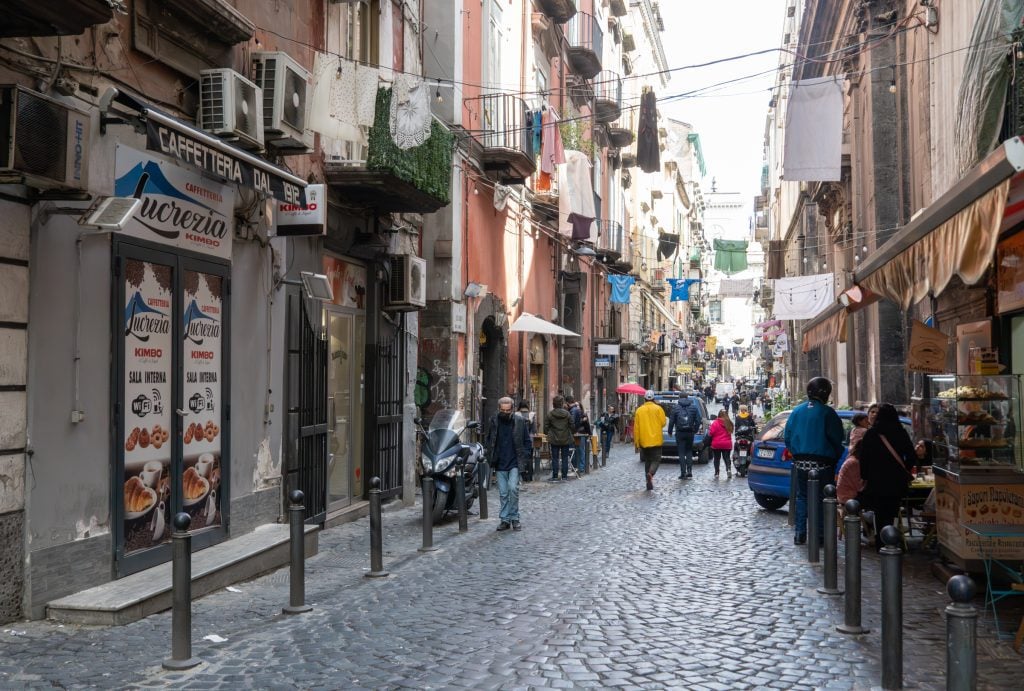
Is Naples Safe?
You might be wondering whether Naples is a safe place to visit in Italy, and I understand — Naples hasn’t always had the greatest reputation. But what you should know is that nowadays, Naples is as safe as any other major city in Europe today.
Naples might not be as chic as Milan or as sophisticated as Florence, and poverty is more visible here, but that doesn’t mean it’s less safe for you as a traveler. People in Naples look out for each other, and it’s much, much safer than it used to be a few decades ago.
For the most part, you can stay safe in Naples by doing what you’d do in any other major city: keep an eye on your belongings; use a crossbody purse that zips shut; limit your drinking; call a taxi at night if you don’t want to walk or take transit. You can see more in my travel safety tips for women.
Other than the basics, in Naples I would recommend avoiding the port area and the area around the train station after dark, and being extra cautious when crossing streets, as the driving here is as wild as it gets. Don’t drive here if you don’t thrive in a chaotic driving environment.
Read More: Solo Female Travel in Italy: Is it Safe?

How Much Time to Spend in Naples Italy
How much time do you actually need in Naples, Italy? Lots of people pop in for a single day visit and head off to Sorrento, and it makes my heart hurt thinking about how much those travelers are missing!
I personally recommend spending three days in Naples — two days for exploring the city, and one day reserved for the day trip of your choice (Pompeii, Procida, Amalfi Coast, etc.).
Eat pizza every day. Or multiple times a day. You won’t regret it!
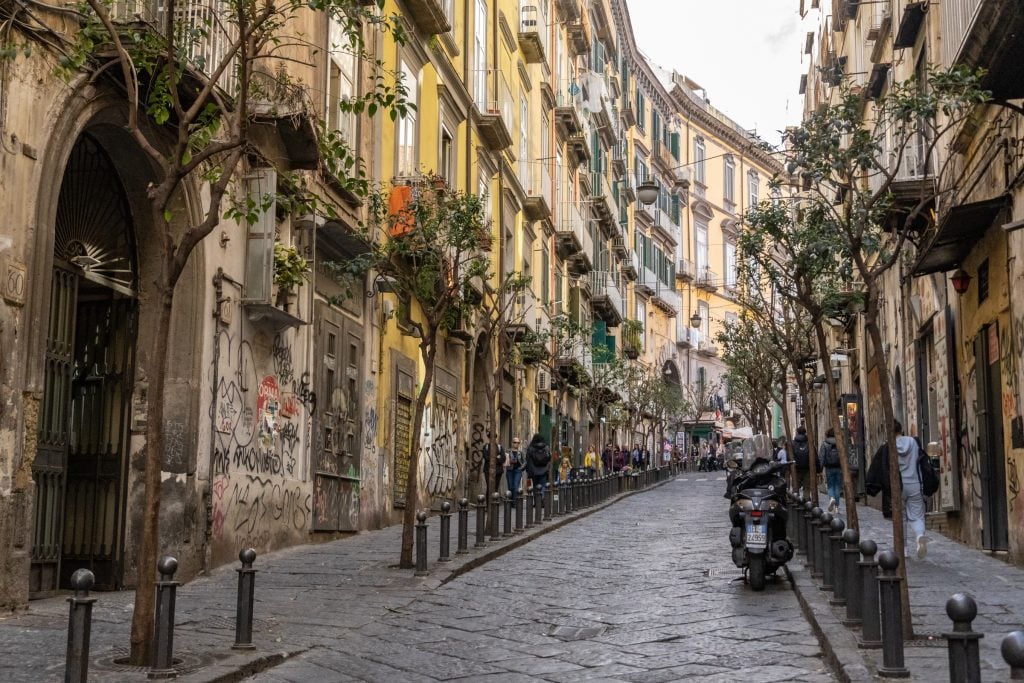
How to Get to Naples, Italy
Naples is extremely well-connected by airlines. Budget airlines connect Naples with cities all over the European continent, and there are easy connections from North America and beyond (often through Milan, Rome, or Frankfurt). I recommend checking Skyscanner for the best rates.
As for traveling within Italy, there are plenty of train connections to Naples, including high-speed connections. I recommend planning European train journeys with Omio.
There are abundant bus and ferry connections to Naples as well.
If you’re road-tripping through Italy, though, I urge you not to drive in Naples. You won’t need a car in the city and the driving here can be really awful. Leave your car outside the city, or make this the end or beginning of your trip.
Read More: 17 Must-Know Tips for Driving in Italy
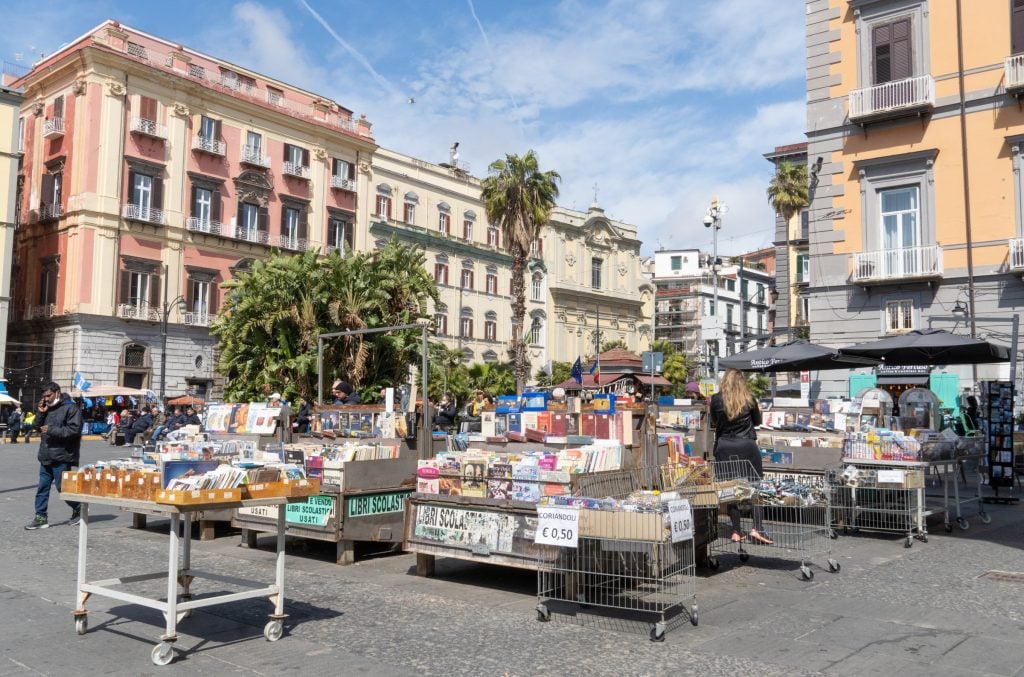
Best Time to Visit Naples, Italy
Naples is a thriving city where people live year-round, and for that reason, you can visit Naples at any time of year and have a great time. But what time is best?
In general, I think Italy is best visited during the spring and fall (perhaps the fall a bit more than spring), and that goes for Naples as well. But because it’s a bit warmer in Campania and Southern Italy, you can enjoy a longer summer. You can swim as early as May or as late as October.
If I were planning a sun-beach-and-water trip to the Bay of Naples (Naples, Amalfi Coast, islands, etc.) — I would go in early June or early October. If it’s just a city getaway to Naples, I think April, May, October, or November would be lovely.
Summer can get extremely hot, crowded, and expensive. And don’t think that September is shoulder season — September is now the priciest month of the year for accommodation on the Amalfi Coast!
If you visit in winter, this can be a cheap and crowd-free time to visit — but keep in mind that many buildings in Southern Italy are not heated well at all. I learned that the hard way in Sicily in winter, and this can often make it feel even colder than it is. Be sure to bundle up, even if it’s warmer than winter in your home.
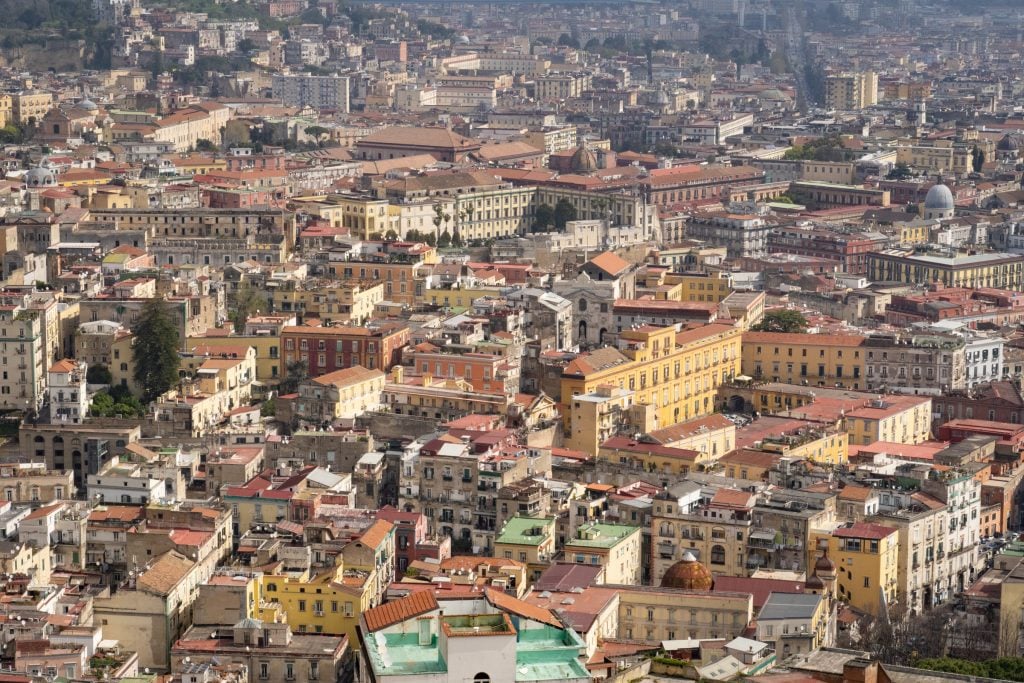
Where to Stay in Naples, Italy
Accommodation in Naples can be a bit tricky. There aren’t as many high quality hotels here than in other Italian cities, and you might notice that there are very few chains you’ve heard of.
In general, I recommend staying within walking distance of the historic center, or near the Quartieri Spagnoli. Avoid the area by the train station. And if you’re looking for something more high-end, some of the more luxurious hotels are along the waterfront.
Even so, I’ve gone through the list and picked out a few with high ratings from the best neighborhoods:
Top-Rated Hotels in Naples Italy:
- Top-Rated Luxury Hotel in Naples, Italy: Amadomus Luxury Suites has gorgeous, high-quality suite-style rooms a stone’s throw from the historic center of Naples.
- Top-Rated Mid-range Hotel in Naples, Italy: Sanfelice 33 Luxury Suites features modern, colorful rooms, some with balconies looking over the vibrant street life!
- Top-Rated Budget Hotel in Naples, Italy: Il Taschino Suite is a bit between the Centro Storico and Quartieri Spagnoli and features simple rooms in a great area for a low price.
Find deals on hotels in Naples here.
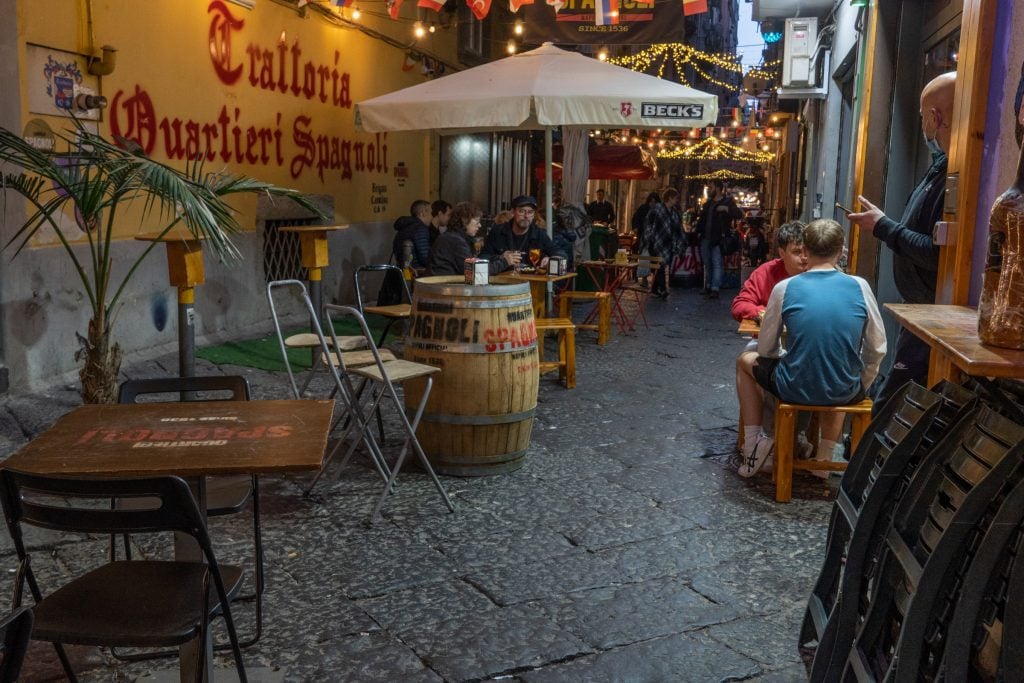
Travel Insurance for Italy
One last note — it’s absolutely vital to have travel insurance before traveling to Naples, or anywhere in Italy. If you get sick or injured on your trip, if you get robbed, or even if you have to be flown home for more care, travel insurance will protect you from financial ruin. World Nomads is a company I have used for trips to Italy.
Travel insurance will help you in your hour of need if you come down with appendicitis in Naples, or trip and break an ankle while climbing down those stairs, and if your flights get canceled, you can get accommodation and new flights paid for.
As always, be sure to read your policy carefully and make sure it’s a fit for you. See what World Nomads covers here.
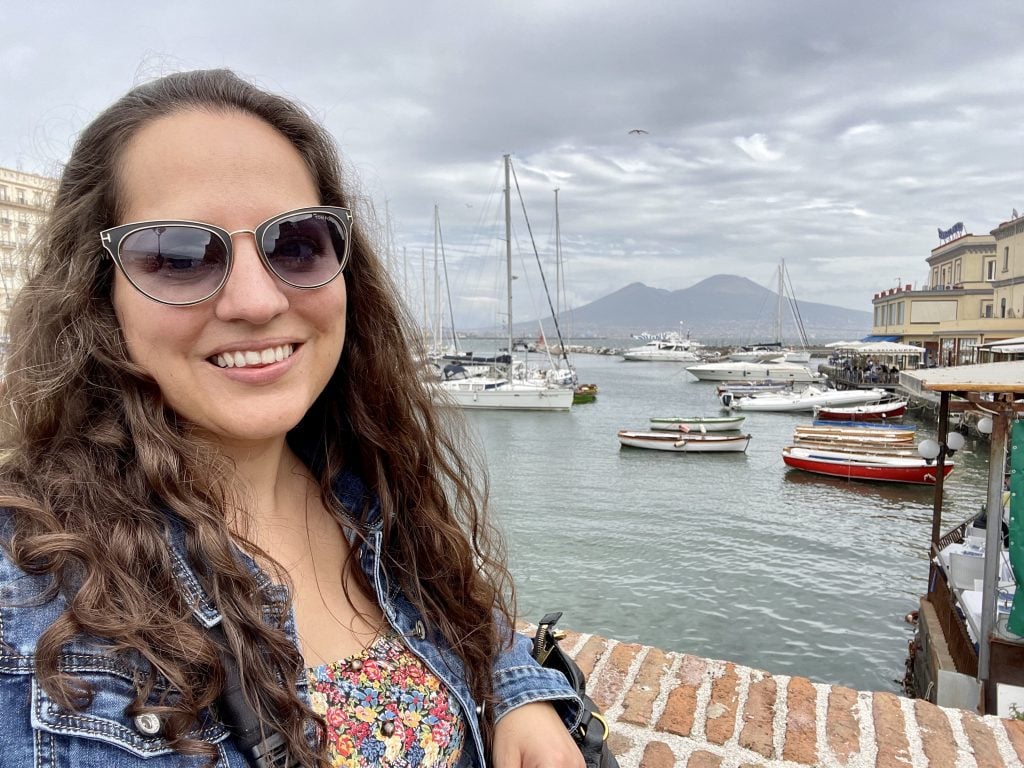
Is Naples Worth It?
Naples is one of my favorite cities, and a place that I will ALWAYS be happy to come back to — so YES, Naples is absolutely, 100% worth it. In fact, I wish that more travelers to Italy spent more time in Naples.
So many people think that Naples is only a place to visit quickly before heading out to the more aesthetically pleasing destinations of the Bay of Naples, from Positano to Sorrento to Capri.
But Naples is such an interesting place to visit on its own. And if you let it get under your skin, I know you’ll love it as much as I do.
Go enjoy your time in Naples — then come back and tell me all about it!
Planning a Trip to Italy:
- What NOT to Do in Italy
- Solo Female Travel in Italy: Is it Safe?
- Ultimate Guide to Driving in Italy
- How to Stay at an Agriturismo in Italy
- 30 Cities in Italy Most Worth Visiting
- 30 Stunning Mediterranean Islands To Visit In Your Lifetime
Cool Places in Southern Italy:
- Tropea, Italy: A Spectacularly Situated Beach Town
- The Stunning Trulli of Alberobello, Italy
- The Joys and Challenges of Traveling in Sicily
- Where to Go in Eastern Sicily
- 23 Fun Things to Do in Palermo, Sicily
- Complete Guide to the Aeolian Islands, Sicily
- Aci Trezza: A Laid-Back Coastal Town in Sicily
- Visiting Sicily in the Winter: Worth it or not?
- 22 Best Places to Visit in Sicily
- 16 Fun Things To Do In Sorrento
- 16 Fab Things to do in Lecce, Italy
- 17 Fun Things to do in Bari, Italy
- 15 Best Things to do in Monopoli, Italy
- 17 Fun Things to do in Matera, Italy
Cool Places in Northern Italy:
- Three Weeks in Northern Italy: An Itinerary
- Parma, Italy: A Colorful, Artsy, Delicious Town
- Where to Stay in Rome: Best Neighborhoods and Accommodation
- Three Days in the Dolomites: A South Tyrol Getaway
- Best Day Trips from Florence, Italy
- The Immaculate, Bursting Mosaics of Ravenna, Italy
- 25 Best Food Experiences in Emilia-Romagna, Italy
- 23 Best Things to Do in Bologna, Italy
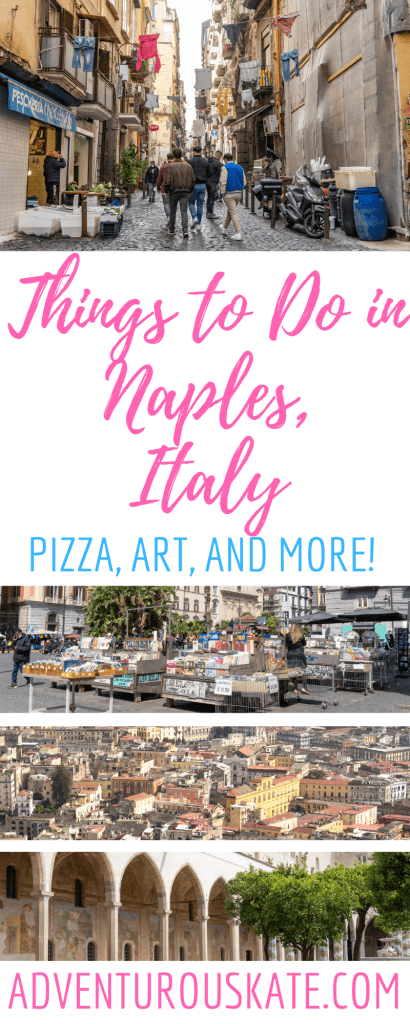
Have you been to Naples Italy? What’s your favorite thing to do? Share away!